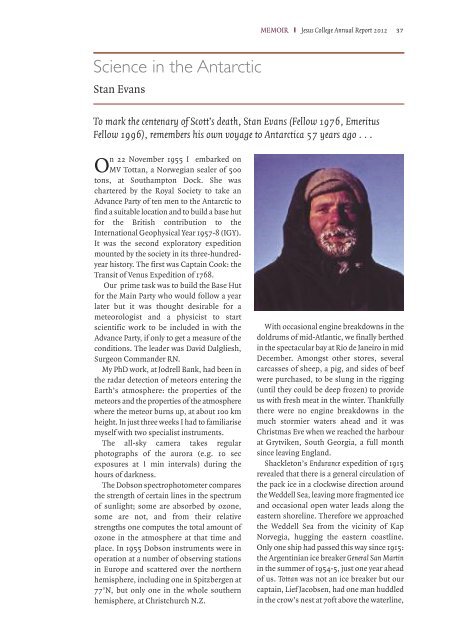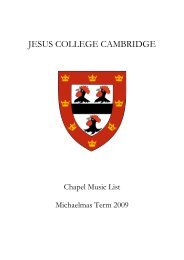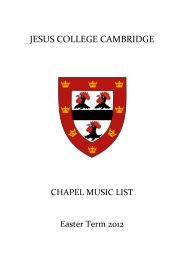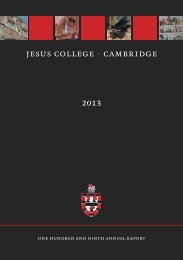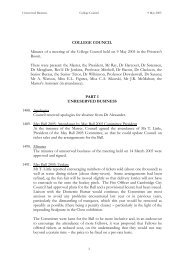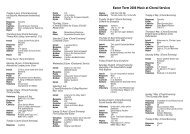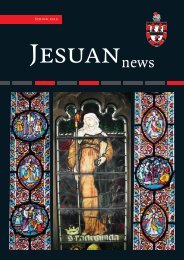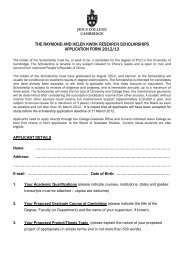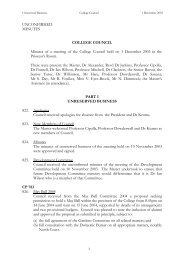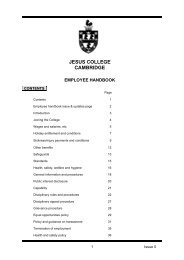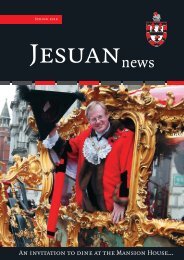2012 Annual Report - Jesus College - University of Cambridge
2012 Annual Report - Jesus College - University of Cambridge
2012 Annual Report - Jesus College - University of Cambridge
Create successful ePaper yourself
Turn your PDF publications into a flip-book with our unique Google optimized e-Paper software.
Science in the Antarctic<br />
Stan Evans<br />
On 22 November 1955 I embarked on<br />
MV Tottan, a Norwegian sealer <strong>of</strong> 500<br />
tons, at Southampton Dock. She was<br />
chartered by the Royal Society to take an<br />
Advance Party <strong>of</strong> ten men to the Antarctic to<br />
find a suitable location and to build a base hut<br />
for the British contribution to the<br />
International Geophysical Year 1957-8 (IGY).<br />
It was the second exploratory expedition<br />
mounted by the society in its three-hundredyear<br />
history. The first was Captain Cook: the<br />
Transit <strong>of</strong> Venus Expedition <strong>of</strong> 1768.<br />
Our prime task was to build the Base Hut<br />
for the Main Party who would follow a year<br />
later but it was thought desirable for a<br />
meteorologist and a physicist to start<br />
scientific work to be included in with the<br />
Advance Party, if only to get a measure <strong>of</strong> the<br />
conditions. The leader was David Dalgliesh,<br />
Surgeon Commander RN.<br />
My PhD work, at Jodrell Bank, had been in<br />
the radar detection <strong>of</strong> meteors entering the<br />
Earth’s atmosphere: the properties <strong>of</strong> the<br />
meteors and the properties <strong>of</strong> the atmosphere<br />
where the meteor burns up, at about 100 km<br />
height. In just three weeks I had to familiarise<br />
myself with two specialist instruments.<br />
The all-sky camera takes regular<br />
photographs <strong>of</strong> the aurora (e.g. 10 sec<br />
exposures at 1 min intervals) during the<br />
hours <strong>of</strong> darkness.<br />
The Dobson spectrophotometer compares<br />
the strength <strong>of</strong> certain lines in the spectrum<br />
<strong>of</strong> sunlight; some are absorbed by ozone,<br />
some are not, and from their relative<br />
strengths one computes the total amount <strong>of</strong><br />
ozone in the atmosphere at that time and<br />
place. In 1955 Dobson instruments were in<br />
operation at a number <strong>of</strong> observing stations<br />
in Europe and scattered over the northern<br />
hemisphere, including one in Spitzbergen at<br />
77°N, but only one in the whole southern<br />
hemisphere, at Christchurch N.Z.<br />
MEMOIR I <strong>Jesus</strong> <strong>College</strong> <strong>Annual</strong> <strong>Report</strong> <strong>2012</strong> 37<br />
To mark the centenary <strong>of</strong> Scott’s death, Stan Evans (Fellow 1976, Emeritus<br />
Fellow 1996), remembers his own voyage to Antarctica 57 years ago . . .<br />
With occasional engine breakdowns in the<br />
doldrums <strong>of</strong> mid-Atlantic, we finally berthed<br />
in the spectacular bay at Rio de Janeiro in mid<br />
December. Amongst other stores, several<br />
carcasses <strong>of</strong> sheep, a pig, and sides <strong>of</strong> beef<br />
were purchased, to be slung in the rigging<br />
(until they could be deep frozen) to provide<br />
us with fresh meat in the winter. Thankfully<br />
there were no engine breakdowns in the<br />
much stormier waters ahead and it was<br />
Christmas Eve when we reached the harbour<br />
at Grytviken, South Georgia, a full month<br />
since leaving England.<br />
Shackleton’s Endurance expedition <strong>of</strong> 1915<br />
revealed that there is a general circulation <strong>of</strong><br />
the pack ice in a clockwise direction around<br />
the Weddell Sea, leaving more fragmented ice<br />
and occasional open water leads along the<br />
eastern shoreline. Therefore we approached<br />
the Weddell Sea from the vicinity <strong>of</strong> Kap<br />
Norvegia, hugging the eastern coastline.<br />
Only one ship had passed this way since 1915:<br />
the Argentinian ice breaker General San Martin<br />
in the summer <strong>of</strong> 1954-5, just one year ahead<br />
<strong>of</strong> us. Tottan was not an ice breaker but our<br />
captain, Lief Jacobsen, had one man huddled<br />
in the crow’s nest at 70ft above the waterline,


